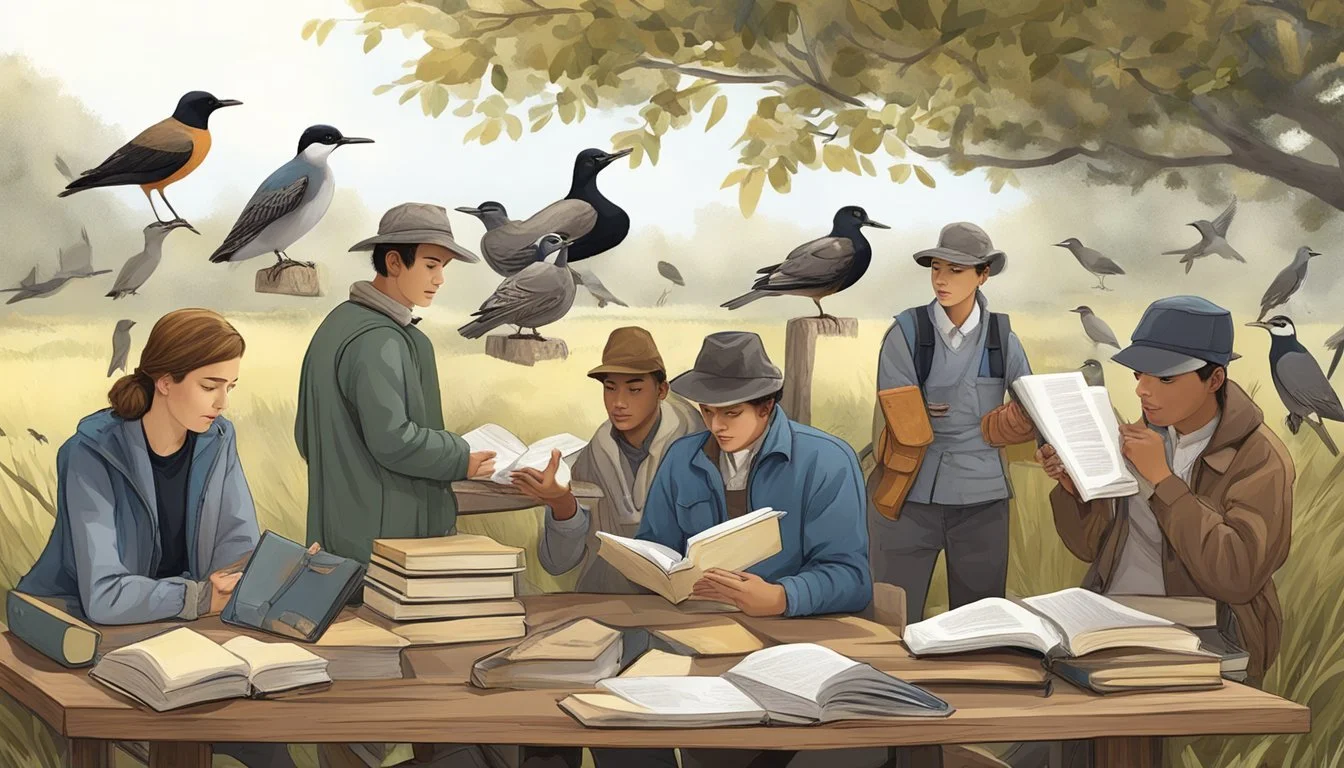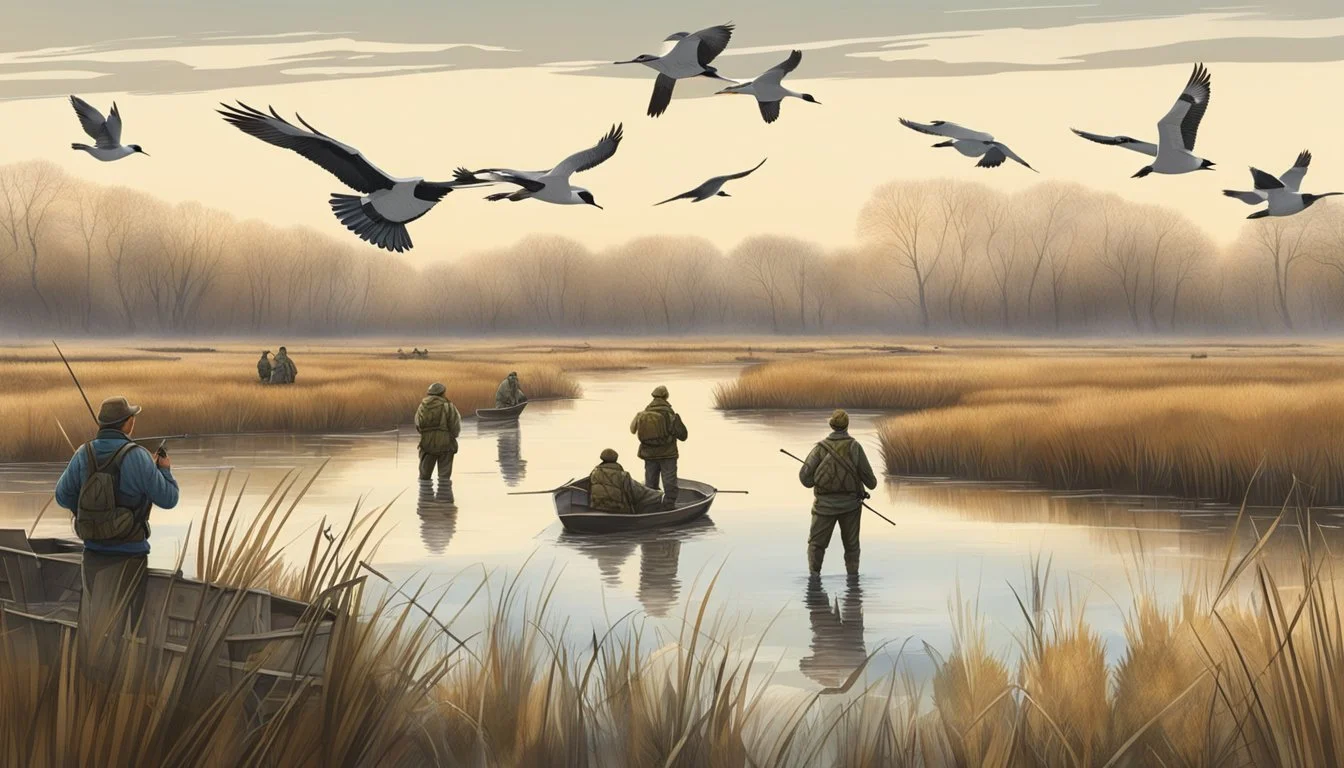Migratory Birds Hunting for Beginners
Essential Tips for Ethical Practices
Migratory bird hunting offers a unique challenge and experience to outdoor enthusiasts. It requires a blend of skill, patience, and knowledge, particularly as different species follow distinct migratory patterns that can be affected by weather and terrain. For beginners, understanding these patterns is crucial for identifying where waterfowl are likely to feed and roost. Recognizing species and their behaviors is more than just part of the sport; it's a responsibility to ensure sustainable and ethical hunting practices.
Before venturing into the field, novice hunters need to familiarize themselves with various regulations that govern the hunting of migratory birds. Compliance with these laws, which include obtaining the appropriate permits or stamps, is mandatory and contributes to the conservation efforts that keep bird populations healthy and viable. Proper gear, such as basic calls and decoys, is also essential, not only to attract birds within range but also to create a more effective and responsible hunting experience.
As with any form of hunting, best practices must be strictly followed to ensure safety for the hunter and the conservation of wildlife. This includes adhering to catch limits to control populations and mitigate any potential nuisance to local areas and residents. For migratory bird hunters, joining the tradition means committing to a continual learning process that respects the delicate balance between nature's rhythms and recreational pursuits.
Understanding Migratory Birds
Before embarking on the hunting of migratory birds, hunters must be acquainted with the different species, understand the importance of habitat conservation, and recognize the U.S. Fish and Wildlife Service's role in regulating and maintaining sustainable populations.
Species Identification
Identifying the correct species is paramount in migratory bird hunting. Notable species such as the mallard and wood duck are common targets. Mallards (Anas platyrhynchos) are distinguished by their iridescent green heads in males and brown-speckled plumage in females. Wood ducks (Aix sponsa), on the other hand, display colorful markings and are known for their box-like nesting sites.
Mallard Identification:
Males: Green head, white neck ring, yellow bill.
Females: Brown-speckled plumage, orange bill.
Wood Duck Identification:
Males: Multicolored iridescent plumage, red eyes, white markings.
Females: Grayish-brown body, white eye-ring, white throat.
Hunters should carry a field guide or use a mobile app to aid in proper identification to ensure compliance with hunting regulations.
Habitats and Conservation
Conservation of habitats is integral to protecting migratory bird populations. In North America, migratory birds rely on a variety of habitats including wetlands, forests, and grasslands. The preservation of these habitats is crucial as they provide essential resources such as food and nesting sites. Notable conservation efforts involve:
Wetlands: Essential for waterfowl like mallards and wood ducks for breeding and feeding.
Grasslands and Forests: Significant for myriad species for nesting and stopover sites during migration.
Hunters play a key role in conservation by adhering to regulations designed to prevent habitat degradation and by participating in wildlife conservation initiatives.
U.S. Fish and Wildlife Service Role
The U.S. Fish and Wildlife Service (USFWS) is the primary federal agency responsible for the management and conservation of migratory birds in the United States. They administer the Migratory Bird Treaty Act which includes:
Setting Seasonal Limits: To ensure hunting does not impact long-term survival of species.
Habitat Protection: Through various programs and partnerships to preserve essential habitats for migratory birds.
By understanding and following the guidelines set forth by the USFWS, hunters contribute to the sustainability and ethical pursuit of migratory bird hunting.
Legal Framework for Hunting
In the United States, a strict legal framework guides migratory bird hunting, ensuring the protection of wildlife populations while allowing for regulated hunting activities.
Hunting Regulations and Seasons
Federal Regulations: The U.S. Fish & Wildlife Service establishes the foundational framework for migratory bird hunting regulations. This includes specifying the range of dates within which states may set their hunting seasons. For instance, hunting seasons can open no earlier than September 1 and must close by March 10.
Hunting Season: Each state will select specific season dates that fall within the federal frameworks. Hunting seasons are carefully designed to avoid breeding periods and times of peak migration, to minimize the impact on bird populations.
Licenses, Permits, and Stamps
Hunting License: All hunters are required to obtain a hunting license from the state in which they wish to hunt. Licenses can often be purchased online or at licensed retailers.
Permit and Stamps: Additional federal permits or stamps, such as the Federal Duck Stamp, may be necessary for hunting migratory waterfowl. The funds from these stamps are used for conservation efforts.
Bag and Possession Limits
Bag Limit: This is the maximum number of birds a hunter may take in a single day. The bag limit varies by species and is determined to sustain healthy bird populations.
Possession Limits: Possession limits regulate the total number of birds a hunter can possess at any time. This is usually a multiple of the daily bag limit, but specifics can vary by state and species.
By adhering to these regulations, hunters contribute to the conservation of migratory bird populations, ensuring that the tradition of hunting is balanced with the responsibility of wildlife management.
Essentials of Bird Hunting Equipment
The right equipment is critical for success in bird hunting, ensuring safety, comfort, and increased chances of a good hunt. Hunters need to be equipped with the proper clothing for concealment and weather conditions, firearms that are reliable and suitable for the game, and supportive accessories that aid in luring birds closer.
Clothing and Camouflage
Hats: A hat not only provides protection from the elements but also helps with camouflage. It should match the surroundings to blend into the habitat of the game.
Waders: Waders keep hunters dry in wet environments. Neoprene waders are recommended for cold weather, while breathable ones are best for warmer conditions.
Clothing: Layering is key. Base layers keep moisture away from the skin, mid-layers provide insulation, and outer layers should be waterproof and camouflaged.
Firearms and Ammunition
Shotguns: A reliable, appropriately sized shotgun is a necessity. Most hunters prefer 12-gauge shotguns due to their versatility, but 20-gauge can be suitable for smaller game or longer treks.
Ammunition: Hunters should opt for steel shot or other non-toxic alternatives to lead, as per regulations. The shot size varies based on the species hunted; smaller birds typically require smaller shot.
Decoys, Blinds, and Accessories
Decoys: They play a pivotal role in attracting birds. A mix of feeding, resting, and vigilant posture decoys can create a realistic scene.
Blinds: Concealment is vital. Blinds range from simple natural vegetation to elaborate portable structures. They should blend into the environment seamlessly.
Accessories:
Binoculars: Essential for spotting game from a distance without alerting it.
Accessories: Calls and flagging tools can also be used to attract birds. Additionally, items like game bags for transport, and cleaning tools are important post-hunt.
Hunting Techniques and Best Practices
Mastering effective hunting techniques and adhering to best practices are fundamental to a successful and responsible waterfowl hunting endeavor. They are the elements that blend skill, knowledge, and ethics to elevate a hunter's success rate while preserving the environment.
Scouting and Preparation
Scouting is the first step toward understanding waterfowl behavior and their habitat. Preparation involves studying migration patterns and identifying where these birds are likely to feed or rest. Experts recommend surveying the landscape prior to the hunting season, noting the environment, prevailing winds, and bird movements. Hunters should prepare by familiarizing themselves with their equipment and reviewing hunting seasons regulations to align activities within legal frameworks.
Calls and Patterns
Effectively communicating with waterfowl through calls is an art that requires patience and practice. Each species responds to different calls and patterns, and knowing when and how to use these calls can significantly increase the success rate. A table of common waterfowl species and their preferred calls can be a useful guide for beginners.
Waterfowl Species Call Type Timing Use Mallard Quack and Feed Morning & Dusk Teal Peep and Whistle Throughout Day Goose Cluck and Hiss Feeding Times
Shooting Skills and Safety
Hunters must prioritize safety by practicing firearm safety and ensuring a proper stance and balance for accurate marksmanship. They should spend time honing shooting skills at a range and become comfortable with the mechanics of their firearms. Understanding shot patterns and the importance of shooting within range is paramount to a hunter's effectiveness and techniques. A hunter's shot should always be anchored in safety, patience, and respect for the sport and the environment.
Waterfowl-Specific Strategies
In waterfowl hunting, understanding species-specific behaviors and employing tailored tactics are critical for success. Each type of waterfowl requires a unique approach, and strategies vary between hunting ducks, geese, and other migratory birds.
Ducks and Geese
Habitat: Ducks and geese are typically found in wetlands, rivers, ponds, and lakes. Scouting these areas beforehand is essential to locate flocks. For ducks such as Mallards and Wood Ducks, look for water bodies with ample aquatic vegetation. Conversely, geese, particularly in migration, often utilize larger open waters and adjacent fields for feeding.
Decoys:
Ducks: A mixed spread of decoys imitating local species increases the chances of attraction. Adding motion to the decoy spread, like a ripple maker, mimics natural movements.
Geese: Larger decoy spreads are effective, with a focus on realism in pose and detail to convince wary geese.
Calls: Both ducks and geese respond to species-specific calls. Mastery of various call types—ranging from the Mallard's quack to the Wood Duck's whistle—is needed to effectively mimic these sounds. Practice is crucial, as poorly executed calls can deter birds.
Shooting Times: Activity peaks around dawn and dusk. Positioning in concealment, such as a blind, during these times is advantageous.
Other Migratory Game Birds
Mourning Doves and White-winged Doves favor open fields and edges of woodlands. Hunters typically use pass-shooting strategies, positioning themselves along natural flight paths and preparing for the doves’ swift, erratic flight patterns.
Snipe and American Woodcock habits lead them to marshy and wet wooded areas, respectively. Stealthy, deliberate movements coupled with a ready stance are necessary due to their sudden flushes.
For waterfowl like coot and gallinules, strategies include understanding their vegetation-dense habitats and using a low-profile boat for approach.
Regardless of the targeted species, adhering to legal bag limits and season dates is a must. Always consult current local and federal regulations before heading out to hunt any migratory bird species.
Ethical Hunting and Stewardship
Ethical hunting is a foundational aspect of wildlife conservation and habitat management. It involves adhering to regulations, ensuring safety, and fostering a sustainable environment for migratory birds.
Responsible Practices
Safety and adherence to regulations are paramount in ethical hunting. Hunters should familiarize themselves with the Migratory Bird Treaty Act and state-specific requirements to ensure they are hunting legally. For instance, states like Idaho, Utah, Colorado, Montana, Nebraska, and South Dakota require hunters to obtain necessary hunting licenses and permits.
Safety Measures:
Always wear visible clothing.
Follow proper firearm handling procedures.
Regulation Adherence:
Validate that the species is in-season.
Comply with bag limits and hunting hours.
Wildlife Management and Sustainability
Effective wildlife management and habitat preservation support the principles of conservation and sustainability. Each state participates in various wildlife management programs that balance the ecological needs with recreational hunting activities.
Habitat Preservation Efforts in the aforementioned states include:
Idaho: Restoration of wetlands to ensure waterfowl have a thriving environment.
Montana: Grassland management for maintaining bird populations.
Strategic hunting practices contribute to wildlife conservation efforts by:
Managing bird populations at sustainable levels.
Funding conservation through licenses and permit fees.
Participating in habitat improvement initiatives.
Ethical hunting supports not only the traditions of hunting but also the health of migratory bird populations and their environments.
Additional Considerations for Hunters
In migratory bird hunting, alongside mastering the basics, hunters must pay special attention to their hunting companions and the post-hunt procedures. Improper handling at any stage can affect safety and the overall experience.
Dog Training and Usage
When it comes to using dogs for hunting, training is paramount. A well-trained dog can efficiently retrieve game without causing damage, saving the hunter time and preserving the condition of the bird.
Safety: Ensure that the dog is trained to obey commands promptly to prevent accidents.
Tips: Introduce the dog to water and boats if hunting waterfowl.
Retrieve: Train dogs with dummies before involving them in actual hunting scenarios to ensure they retrieve appropriately.
Cleaning and Cooking Game
Once the hunt is over, properly cleaning and cooking the game is crucial for safe and enjoyable consumption.
Cleaning: Begin by plucking feathers and then remove entrails to prevent contamination.
Cooking: Cook birds to the appropriate internal temperature to reduce the risk of foodborne illness.
Safe Handling:
Step Description Tip Cooling Cool the bird rapidly after harvest. Use a cooler with ice if necessary. Cleaning Clean the bird in a sanitary environment. Wear gloves to minimize contact. Storage Store at proper temperatures to avoid spoilage. Keep birds separate from other food Preparation Prepare the meat using sanitary tools and surfaces. Marinate for flavor and tenderness. Cooking Cook to at least 165°F to ensure safety. Use a meat thermometer to check.
General Hunting Advice
When engaging in hunting, one should understand the distinct approaches required for various types of game and the importance of connecting with experienced hunters.
Small Game Versus Waterfowl
Small game hunting and waterfowl hunting are two popular forms of hunting, each with its own set of techniques and regulations. Small game hunting typically focuses on animals such as rabbits, squirrels, and certain birds, while waterfowl hunting pertains to ducks, geese, and related species.
Legal Considerations: Waterfowl hunters are subject to more stringent federal regulations due to international treaties protecting migratory birds. It's crucial to be well-versed in these laws, which govern everything from the type of bait that can be used to the specific seasons and limits on the number of birds that can be harvested.
Required Gear: For waterfowl, a hunter must have a shotgun (typically 12-gauge), non-toxic shotshells, decoys, and, in some cases, a boat or blind. Small game hunting, while also gear-intensive, may entail lighter equipment, such as .22 caliber rifles or smaller gauge shotguns.
Learning from Hunting Communities
Becoming a proficient hunter often involves learning from those with more experience. There are many avenues through which a novice hunter can gain insight and knowledge:
Local Hunting Clubs: Joining a hunting club can give one access to a wealth of communal knowledge, as well as opportunities to participate in organized hunts.
Online Forums: Hunters can also leverage online communities to ask questions, read stories, and find out about the latest gear and strategies. They are a valuable resource for both beginners and seasoned outdoor enthusiasts.
Hunting Courses: Most areas require hunters to complete a safety course. Beyond safety, these courses often provide tips on local hunting strategies, animal behavior, conservation, and tracking.
Incorporating the advice and lessons learned from both small game and waterfowl hunters helps improve skills and enriches the overall hunting experience.
Conclusion
In the pursuit of migratory bird hunting, adhering to regulations and implementing best practices are paramount. They ensure the tradition continues in a responsible, sustainable manner.
Recap and Continuous Education
Migratory bird hunting requires a hunter to be familiar with species identification, local and federal regulations, and sustainable hunting techniques. Hunters must also invest in appropriate gear and develop proficiency in various hunting methods.
Continuing education is essential for the hunter's growth and the protection of the delicate ecosystem. They should stay updated with changes in laws and best practices through credible resources and wildlife agencies. This commitment maintains the delicate balance between the sport of hunting and the conservation of migratory bird populations.








